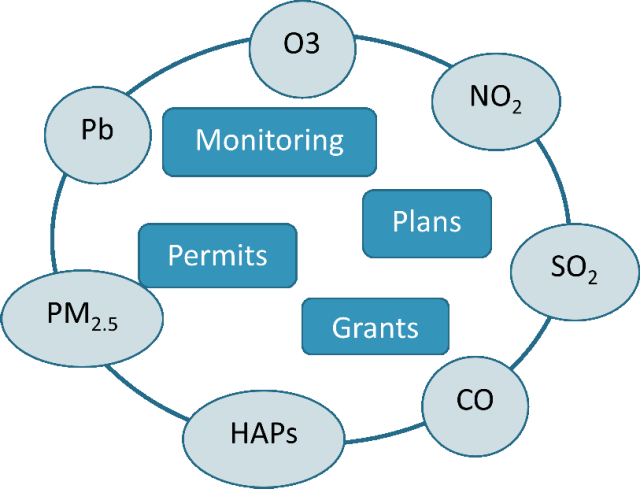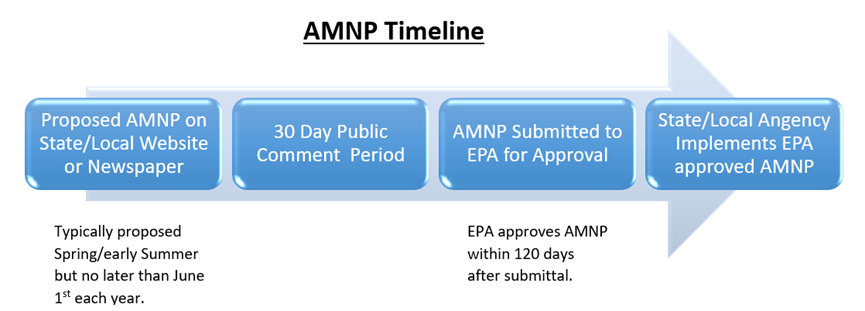CAA Public Input
On this page:
Background - Monitoring - Plans - Permits - Grants
Opportunities for Public Engagement in Actions conducted under the Clean Air Act in EPA Region 3
Opportunities for public engagement under the Clean Air Act (CAA) occur at both the state and federal levels. The information here focuses on public engagement opportunities for those Clean Air Act actions conducted at EPA Region 3. EPA actions such as those pertaining to nation-wide industrial standards are initiated by EPA’s Headquarters and are not further described here. State and local actions required by the CAA are initiated by state and local agencies and are also not further described here. However, links to state and local websites are provided for those interested in participating in the state and local public engagement process.
Background: All regulatory rulemaking under the CAA and submittals made by state and local agencies are based on meeting the National Ambient Air Quality Standards (NAAQS) for six major pollutants, referred to as criteria pollutants.
The criteria pollutants are: carbon monoxide (CO), lead (Pb), ozone (O3), nitrogen dioxide (NO2), fine particulate matter (PM2.5), sulfur dioxide (SO2). Furthermore, ozone is not emitted directly but is formed from volatile organic compound (VOC) and nitrogen oxide (NOx) emissions, which are emitted directly. The CAA requires that EPA review the NAAQS every 5 years and offer the opportunity for public engagement as part of those reviews.
The Clean Air Act also regulates air toxic compounds. Also known as Hazardous Air Pollutants (HAPs), the programs pertaining to industrial standards, compliance and monitoring are conducted at the national level.
Opportunities for meaningful public participation under the CAA can be difficult to determine for non-governmental stakeholders. The information here is designed to make these opportunities more transparent. Below are the areas under the Clean Air Act where and when there are opportunities for public engagement in the Clean Air Act activities in EPA Region 3.

Public Input Areas
|
EPA Initiated Actions |
|
|
|
|
*Indicates an opportunity for public input
EPA Initiated Actions
Industrial Standards
- Regulations for:
- Emissions standards
- Compliance
- Compliance Monitoring
- Categories:
- New Source Performance Standards (NSPS)
- Maximum Achievable Control Technology (MACT)
- Technology component of the National Emission Standards for Hazardous Air Pollutants (NESHAP) program
National Ambient Air Quality Standards (NAAQS)
- New level of the standard
- Changes in requirements of the standard
- NAAQS Reviews by EPA
Air Monitoring
Nation-wide EPA Action
- New NAAQS monitoring rules.
- EPA conducts rulemaking to propose a new NAAQS, which includes a proposed or updated monitoring rule.
Region 3 Actions
- Approval of Annual Monitoring Network Plans (AMNP)
- Plans developed by state and local agencies to adhere with the NAAQS monitoring rules.
- Region 3 state and local agencies websites:

Community Initiated Actions
- Program is designed to assist community groups, educators, state agencies, local agencies, and tribes with conducting their own small-scale localized air monitoring projects by loaning portable air quality sensors to the public.
NAAQS Plans

- State Process: States draft a plan or rulemaking for inclusion in their SIP, which requires EPA action (see Step 4).
- States must offer a minimum 30-day public comment. This is an opportunity for the public to make comments that can change the state rule or action, which can include emission standards, industrial practices, recordkeeping, monitoring. modeling and other facility requirements.
- The state will then finalize their rule after taking into consideration any comments received. Once the state rule is finalized, the state will submit the final state rule to EPA for inclusion into the SIP.
- Federal Process: After evaluation, EPA proposes to make the state’s final rule part of the State Implementation Plan (SIP).
- EPA proposes approval or disapproval and offers a 30-day public comment period on the proposal. This is an opportunity for the public to make comments on EPA’s action. Comments during this time are limited to whether EPA should incorporate the rule into the SIP.
- EPA publishes a final action, which may reflect changes or clarifications due to public comment and which will include a response to comments.
Air Permits
In Region 3, states are delegated authorities for issuing federally enforceable permits. As such, EPA’s primary role is limited to oversight of state and local actions. Click here for more information on Clean Air Act (CAA) permitting in EPA Region 3.
The permitting authority will provide notice to the public, via an online bulletin or local newspaper, that a permit is up for public review and comment. The public will have at least 30 days to review and provide comments on the permit.
Required State & Local Agency Actions
For certain air emission control requirements to be federally enforceable in an air permit, the following steps must occur:
- CAA Requirements Finalized by State/Local Agency
Industrial source emission control requirements are finalized by the State. Control requirements finalized by the State include:- Reasonably Available Control Technology (RACT)
- Best Available Retrofit Technology (BART)
- Proposed SIPs
The CAA requirements finalized by the State then go into a proposed State Implementation Plan (SIP). Proposed SIPs contain the proposed industrial control requirements that need to be adopted into the SIP in order to be federally enforceable.Once the Proposed SIP Revision is notified to the public, the public has 30 days to provide comments.
- Final SIPs
The Proposed SIP is then finalized, resulting in the Final federally enforceable SIP. This SIP cannot be changed without going through the rulemaking process (Steps 1 and 2). - Air Permits
Applicable requirements from Final SIPs and Federal Control Requirements are used to create conditions in the air permits.Once a draft permit is ready for public review, the public is notified and is given at least 30 days to provide comments. Previously approved SIP or nation-wide control requirements are not open to comment during this comment period.
Grant Opportunities
Community Focused Grants
Grants that communities can apply for:
American Rescue Plan
- General: EPA ARP Website | EPA’S ARP funding| White House ARP website | EJ Initiatives under ARP | Community Spotlight: ARP Funding Recipients and Stories | Air Quality Initiatives
- Enhanced Air Quality Monitoring ARP Funding | Environmental Justice ARP Funding
Bipartisan Infrastructure Law
- General: EPA BIL Website | EPA Funding Announcements from BIL and IRA
- Clean School Bus Program: BIL Clean School Bus Website | 2023 Clean School Bus Rebate Program OPEN | Clean School Bus Reports to Congress
Diesel Emission Reduction Act
- General: EPA DERA Website | DERA Fifth Report to Congress
- DERA National Program OPEN | DERA State Program
Inflation Reduction Act
- General: EPA IRA Website | White House IRA Guidebook | All IRA Open NOFOs (White House) | Invest.gov | EPA Funding Announcements from BIL and IRA | “How Do I Apply for Grants under IRA?” | IRA Tribal Guidebook
- Environmental Justice (EJ) Block Grants: EJ Thriving Communities Grantmaking Program | EJ Collaborative Problem-Solving Cooperative Agreement Program | EJ Government-to-Government Program | The Environmental Justice Thriving Communities Technical Assistance Centers Program
- Greenhouse Gas Reduction Fund (GGRF): GHG Reduction Fund Website | $20B General and Low-Income Assistance Competition | $7B Zero-Emissions Technology Fund Competition
- Climate Pollution Reduction Grants: CPR Grants | Dedicated program inbox | State/Local Program Guidance
*Grant availability is contingent on Congressional budget appropriations. Past availability of funding does not guarantee that additional funds will be made available in the future.
